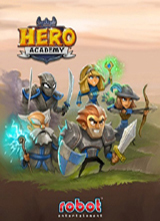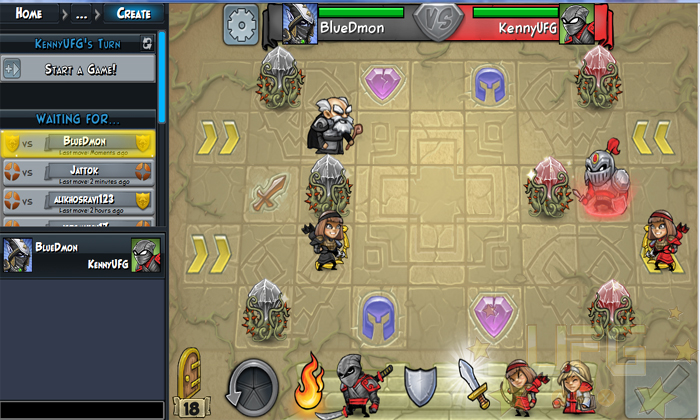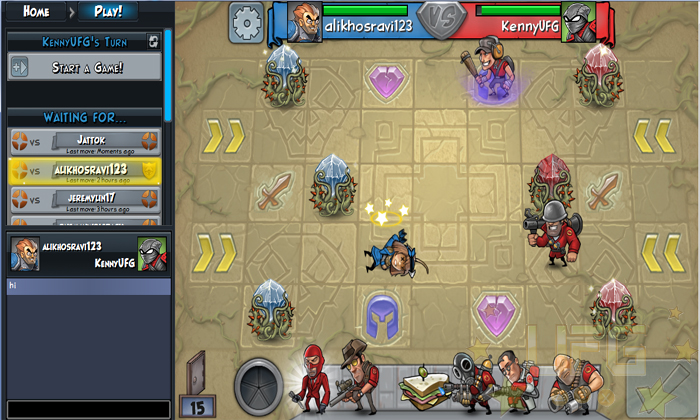Hero Academy
Robot Entertainment made an addictive title in Hero Academy. Released over iOS devices, this turn-based strategy game was a hit with gamers of all ages. So, it’s only right that it was moved over to Steam. Now PC gamers can get in on the fun!
Just like its mobile counterpart, this game is all about strategy. Hero Academy is a multiplayer game where players try to destroy their rival’s Crystals while defending their own. Before a match starts, each player picks a team. The base game comes with two: The Council and Team Fortress 2 (TF2); following Valve’s trend of allowing their characters to be featured in indie games. After the teams are picked the game chooses a random map for the player to play on. Each map has its own tile arrangement; placement of the Crystals and special tiles differ between maps. When the match starts, one player will pick what characters he or she wants to place on the map. Although the number of characters are the same the selection of characters is randomized; kind of like pulling a card from a deck.
Once a character is placed on the map, it can move positions, attack, or defend based on its abilities and stats. The player can also decide if they want to use an item to help boost their teams stats, revive a fallen comrade or to hurt the opposing team. For instance, giving the Knight (Council) a larger sword will increase his attack power. After the first player completes their moves, it’s the other players turn. The catch is that each player only has five moves allotted to them a turn. A move can be anything from placing a character to moving them around the map, using an item, and various other options. Players will have to plan out each step in order to get the most out of a turn. To help them in this is the ability to redo moves; they can test out multiple scenarios without submitting their turn to the other player. Once satisfied with their choices, they can submit their turn, allowing it to play out for the other player.
A lot of the fun comes from the restrictions placed on players. The fact that there are only five moves per turn requires careful planning. Adding to that are special tiles that boost stats when a character steps on them. There is even a TF2 inspired map that has tiles that, when stepped on, summons a train to run down anyone on the tracks. The last strategic element happens to be the characters themselves. Gamers will have to take each character’s strengths and weaknesses into account during play. For instance, the Spy (TF2) character can move up to two spaces at a time. His back stab move is extremely powerful and he can’t be targeted from afar (by snipers, archers, etc.). The fact that he can only move two spaces at a time means it can take a lot of “moves” just to get him in the right position to do the most damage. Also, he can’t attack people without being close to them and if he isn’t stabbing them in the back, he is virtually useless. All of these limitations and attributes have to be weighed when choosing this character over another.
I had a great time playing with random people over Steam. Having to think a few steps ahead of my opponent really allowed me to stretch my strategic muscles. Then there was the advantage of having an extensive amount of time to think and plan since the game is not played in real-time. Unfortunately, I was given too much time during some matches. Hero Academy allows gamers to play multiple people at a time, flipping between each match on a list. Matches can be played leisurely since exiting the game will save the last turn in order for players to continue when they log back on; which can be days at a time. I’m actually waiting on someone to take their turn as I write this review.
While I understand the appeal to be able to play multiple games over the course of a few days, I feel that there should be an option to play timed matches too. Sometimes I don’t want to wait a day to complete my winning move, which seems to be when people “stop” participating. When I get the upper hand they seem to disappear, knowing that if I quit the match they get the win. This may not be their motive, they may actually be taking a few days to plan their move. This doesn’t make waiting any less frustrating though. What’s worse is that I can’t play against an AI team. At least then, I could try out different strategies without having to wait for my opponents to come back from vacation!
Everything else about Hero Academy is great. There are multiple teams with varying abilities; the extra teams cost $4.99 each or you can get the gold edition (featuring every team) for $14.99. Owners of the iOS game can use the TF2 team by using a cool swap feature, connecting the two versions of this title. The graphics are colorful, flash-like sprites, giving the game a humorous cartoony look. There are leaderboards, a challenge/puzzle mode that requires even more strategic thinking, and well-designed maps to battle across. Again, the only thing it’s missing is a timed game option during match making. That would have given those of us who are “impatient” a better gameplay experience.
Gameplay:
7
Hero Academy is really fun to play. More match making options would have been great though!
Graphics:
9
The cartoony graphics are great for this type of game.
Sound:
7
The sound effects sound as they should. The music is ok.
What's New:
7
While not a totally new spin on the genre, there are enough new elements for gamers to enjoy.
Replay Value:
9
The game is really fun to play and the fact that you can play multiple matches at a time is a plus.
Final Score:
7.8



